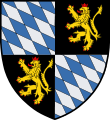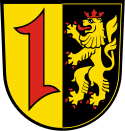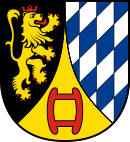Kurpfalz (region)
The Kurpfalz region is in the broadest sense the area in what is now Germany in which the Electoral Palatinate dialect is spoken. In a narrower sense, this includes the part of the historical electorate in today's Baden-Württemberg (see Kurpfalz ), i.e. the Mannheim / Heidelberg region .
Much like today's Swabia , the Electoral Palatinate has no fixed borders. However , the Electoral Palatinate is separated from the Palatinate by the Rhine.
Concept formation
The name Pfalz is derived from the Roman hill Palatine , on which the palace of the Roman emperor was located in ancient times . Palatinate was derived from the name for a castle-like royal court ( Königspfalz ), which the Frankish and German kings and emperors of the Merovingians had built in important places up to the Staufer period .
The Count Palatinate near Rhine, as the Archdealer of the Old Kingdom, was responsible for the imperial court keeping (the imperial palatinate) . The name of his function was later transferred to the country he ruled.
It was only with the Golden Bull of 1356, in which the electoral dignity for the Palatinate Countess near Rhine ( Latin comes palatinus Rheni ) was established, that the term Electoral Palatinate emerged.
dialect
Kurpfälzer are more likely to be the speakers of a particular dialect than an ethnic group. The reason for this is that the historical Electoral Palatinate included many scattered areas along the Upper Rhine , Middle Rhine and Moselle , which often had their own identity. Today parts of the former electorate are located in Baden-Württemberg, Rhineland-Palatinate , Hesse , Bavaria and Alsace . This division was already apparent around 1800 in the course of the coalition wars, when the right-bank part of the electorate became part of Baden , while the left- bank part went to France and then to Bavaria . The term Electoral Palatinate is often used as a demarcation within Baden-Württemberg compared to the Franks in the east, the Württemberg people (or Swabians ) in the southeast and the Baden people in the south. Although the people of the Electoral Palatinate are often counted among the Baden people, they do not see themselves as such.
The Electoral Palatinate is spoken in the Electoral Palatinate on the right bank of the Rhine, the difference to the Upper Palatinate on the left bank is minimal. The Palatinate language area stretches from Mannheim and Viernheim in the north via Weinheim , Heidelberg and Wiesloch to Bruchsal in the south; in the east it extends into the Baden Odenwald via Neckargemünd to Eberbach , Mosbach and Sinsheim . Around 1,500,000 people live in the area of the Electoral Palatinate-speaking area.
history
The historical Electoral Palatinate arose from the Rhineland-Lorraine Palatinate, whose heartland was initially a little further north. After the extinction of the noble family of Ezzonen the area was moved in the 11th century to the south, where it remained until his graduation. After the palatinate had been assigned to various ruling houses, the Wittelsbachers came to power in the 13th century . Among them, the Palatinate near Rhine, soon to be known as the “Electoral Palatinate”, achieved great political importance in southern Germany. After the Bavarian line of the Wittelsbach family died out, the Electorate of Bavaria fell to the Palatinate line in 1777 . From this, the Electorate of Palatinate-Bavaria arose until the Electoral Palatinate was divided ; the Palatinate on the left bank of the Rhine became French during the French Revolutionary Wars , but after the overthrow of Napoleon Bonaparte it became part of the Kingdom of Bavaria that had now been established . The core area of the Electoral Palatinate between the Rhine and Neckar came to the Grand Duchy of Baden in the Reichsdeputationshauptschluss 1803 and has shared its history since then (see Baden in the 19th century).
In the 20th and 21st centuries
Efforts to overcome the split in the old Electoral Palatinate were last made in 1948 by the Lord Mayor of Mannheim, Hermann Heimerich. The fact that these efforts failed was due not least to the fact that the southern German territorial states were superior to the fragmented character of the Electoral Palatinate due to their unity. Cities like Worms , Speyer or Bruchsal could not identify with the historical Electoral Palatinate.
In 2005, the Rhine-Neckar metropolitan region was created through a state treaty to facilitate and strengthen cross-border cooperation. The old Electoral Palatinate is moving closer together again.
Influences of the Electoral Palatinate
coat of arms
The coat of arms of the historical Electoral Palatinate with the Palatinate lion can be found in whole or in part in some coats of arms of today's regional authorities , but mostly without the white and blue diamonds of the Wittelsbachers. Particularly noteworthy is the large coat of arms of Baden-Württemberg , in which it plays a subordinate role in the heraldic sense.

|

|

|

|

|

|

|
| Electoral Palatinate | Bammental | Mannheim | Schwetzingen | Schriesheim | Weinheim | large coat of arms of Baden-Württemberg |
See also the list of coats of arms with the Palatinate lion .
Other influences
- Kurpfalzbrücke - one of Mannheim's Neckar bridges, built between 1947 and 1950
- Electoral Palatinate Chamber Orchestra - is considered the successor to the "Electoral Court Orchestra" of Elector Karl Theodor
- Kurpfälzisches Museum - Museum with archaeological department in Heidelberg
- Kurpfalz-Park - a leisure and wildlife park near Wachenheim (Rhineland-Palatinate)
- Kurpfalzring - an earlier name of today's motorsport racetrack Hockenheimring Baden-Württemberg
- Kurpfälzisches Winzerfest Wiesloch - annual folk festival in Wiesloch
- Kurpfalz-Centrum - administration and shopping building in the center of Leimen
Some companies that have their origins or a branch in the Electoral Palatinate also have the Electoral Palatinate in their name (for example the Porsche Kurpfalz branch).
The dialect cabaret artists Bülent Ceylan , Christian Habekost , Elsbeth Janda , Josefin Lössl , Hans-Peter Schwöbel and Arnim Töpel , as well as the dialect singers Joana , Joy Fleming are also known beyond the borders of the Electoral Palatinate.
literature
- Schweickert, Alexander: Kurpfalz, Kohlhammer 1997, ISBN 978-3170140387
- Schaab, Meinhard: History of the Electoral Palatinate, Vol. 1 Middle Ages, Kohlhammer 1988, ISBN 978-3170098008
- Schaab, Meinhard: History of the Electoral Palatinate, Vol. 2 Modern Times, Kohlhammer 1992, ISBN 978-3170098770
Individual evidence
- ^ Headquarters for educational media in the Internet eV - http://www.zum.de